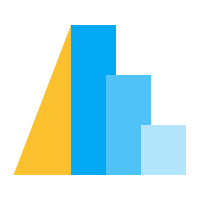Filter Transform#
The filter transform removes objects from a data stream based on a provided
filter expression, selection, or other filter predicate. A filter can be
added at the top level of a chart using the Chart.transform_filter()
method. The argument to transform_filter can be one of a number of
expressions and objects:
A Vega expression expressed as a string or built using the
exprmoduleA Field predicate, such as
FieldOneOfPredicate,FieldRangePredicate,FieldEqualPredicate,FieldLTPredicate,FieldGTPredicate,FieldLTEPredicate,FieldGTEPredicate,A Selection predicate or object created by
selection()A Logical operand that combines any of the above
We’ll show a brief example of each of these in the following sections
Filter Expression#
A filter expression uses the Vega expression language, either specified
directly as a string, or built using the expr module.
This can be useful when, for example, selecting only a subset of data.
For example:
import altair as alt
from altair import datum
from vega_datasets import data
pop = data.population.url
alt.Chart(pop).mark_area().encode(
x='age:O',
y='people:Q',
).transform_filter(
(datum.year == 2000) & (datum.sex == 1)
)
Notice that, like in the Filter Transform, data values are
referenced via the name datum.
Field Predicates#
Field predicates overlap somewhat in function with expression predicates, but have the advantage that their contents are validated by the schema. Examples are:
FieldEqualPredicateevaluates whether a field is equal to a particular valueFieldOneOfPredicateevaluates whether a field is among a list of specified values.FieldRangePredicateevaluates whether a continuous field is within a range of values.FieldLTPredicateevaluates whether a continuous field is less than a given valueFieldGTPredicateevaluates whether a continuous field is greater than a given valueFieldLTEPredicateevaluates whether a continuous field is less than or equal to a given valueFieldGTEPredicateevaluates whether a continuous field is greater than or equal to a given value
Here is an example of a FieldEqualPredicate used to select just the
values from year 2000 as in the above chart:
import altair as alt
from vega_datasets import data
pop = data.population.url
alt.Chart(pop).mark_line().encode(
x='age:O',
y='sum(people):Q',
color='year:O'
).transform_filter(
alt.FieldEqualPredicate(field='year', equal=2000)
)
A FieldOneOfPredicate is similar, but allows selection of any number
of specific values:
import altair as alt
from vega_datasets import data
pop = data.population.url
alt.Chart(pop).mark_line().encode(
x='age:O',
y='sum(people):Q',
color='year:O'
).transform_filter(
alt.FieldOneOfPredicate(field='year', oneOf=[1900, 1950, 2000])
)
Finally, a FieldRangePredicate() allows selecting values within a
particular continuous range:
import altair as alt
from vega_datasets import data
pop = data.population.url
alt.Chart(pop).mark_line().encode(
x='age:O',
y='sum(people):Q',
color='year:O'
).transform_filter(
alt.FieldRangePredicate(field='year', range=[1960, 2000])
)
Selection Predicates#
Selection predicates can be used to filter data based on a selection. While
these can be constructed directly using a SelectionPredicate class,
in Altair it is often more convenient to construct them using the
selection() function. For example, this chart uses a multi-selection
that allows the user to click or shift-click on the bars in the bottom chart
to select the data to be shown in the top chart:
import altair as alt
from vega_datasets import data
pop = data.population.url
selection = alt.selection_point(fields=['year'])
top = alt.Chart().mark_line().encode(
x='age:O',
y='sum(people):Q',
color='year:O'
).properties(
width=600, height=200
).transform_filter(
selection
)
bottom = alt.Chart().mark_bar().encode(
x='year:O',
y='sum(people):Q',
color=alt.condition(selection, alt.value('steelblue'), alt.value('lightgray'))
).properties(
width=600, height=100
).add_parameter(
selection
)
alt.vconcat(
top, bottom,
data=pop
)
Logical Operands#
At times it is useful to combine several types of predicates into a single selection. This can be accomplished using the various logical operand classes:
These are not yet part of the Altair interface
(see Issue 695)
but can be constructed explicitly; for example, here we plot US population
distributions for all data except the years 1950-1960,
by applying a LogicalNotPredicate schema to a FieldRangePredicate:
import altair as alt
from vega_datasets import data
pop = data.population.url
alt.Chart(pop).mark_line().encode(
x='age:O',
y='sum(people):Q',
color='year:O'
).properties(
width=600, height=200
).transform_filter(
{'not': alt.FieldRangePredicate(field='year', range=[1950, 1960])}
)
Transform Options#
The transform_filter() method is built on the FilterTransform
class, which has the following options:
Property |
Type |
Description |
|---|---|---|
filter |
The
|
